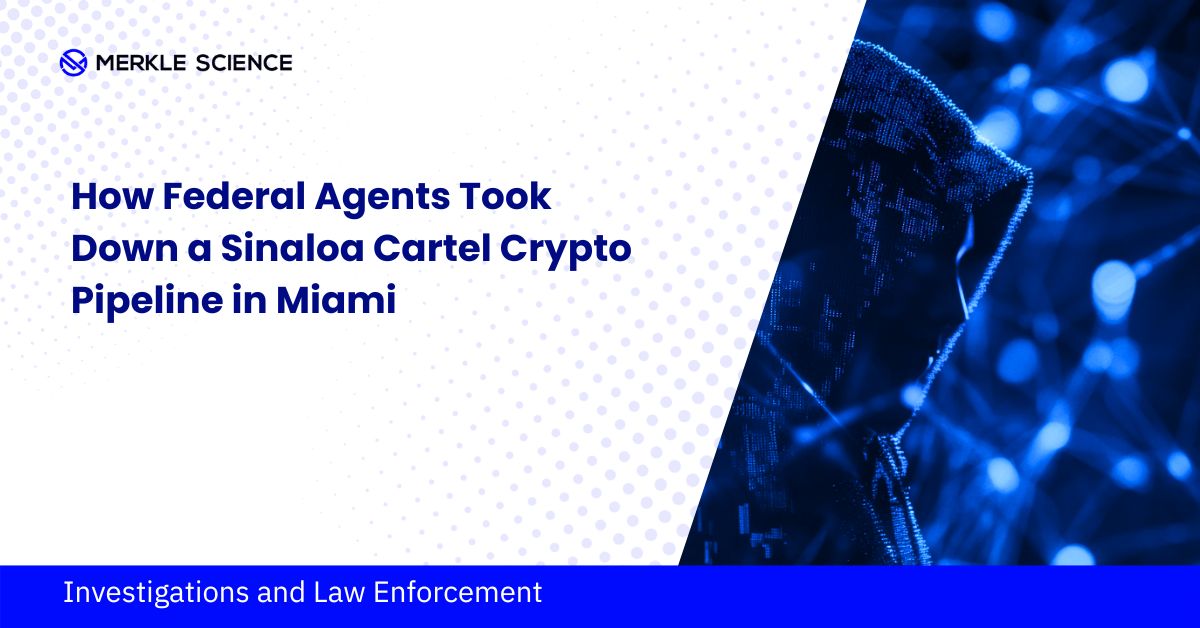When it comes to drug trafficking, the Sinaloa Cartel has long relied on sophisticated global networks and logistics. Now, as criminal groups increasingly turn to cryptocurrency to hide and move money, law enforcement is adapting just as aggressively.
Earlier this month, federal agents delivered a major blow to the cartel’s financial infrastructure. In a coordinated operation in Miami, the DEA and FBI seized over $10 million in cryptocurrency directly tied to the Sinaloa Cartel, one of the most powerful drug trafficking organizations in the world and officially designated as a Foreign Terrorist Organization by the U.S. government.
This wasn't just another asset forfeiture. It was a clear sign that law enforcement is ready to chase criminal finances wherever they go, even deep into digital territory.
Cartel Cryptocurrency Seizure Highlights Rise in Crypto-Fueled Crime
For years, traffickers have used shell companies, mules, and wire transfers to launder drug money. But crypto has added a new layer of complexity. The Sinaloa Cartel leveraged digital assets to obscure its financial trails, using decentralized systems to move illicit proceeds quickly and often anonymously across borders.
In the Miami case, agents uncovered a complex laundering scheme involving multiple wallets and obfuscation techniques. Using advanced blockchain tracing tools and financial intelligence, investigators were able to untangle the web of transactions and freeze the funds before they could be dispersed or cashed out.
As DEA Acting Administrator Robert Murphy stated, “DEA is hitting the cartels where it hurts—with arrests, with seizures, and with relentless pressure. From meth labs in California to fentanyl pills disguised as pharmaceuticals seized at our border, these operations are saving American lives every single day. We are not slowing down. We are dismantling these networks piece by piece, and we won't stop until the last brick of their empire falls.”
Operation Take Back America: A Multi-State Crackdown on Digital Asset Laundering
The crypto seizure in Florida was just one part of a sweeping multi-state crackdown called Operation Take Back America. Since January, federal agents have:
- Seized 44 million fentanyl pills
- Confiscated 4,500 pounds of fentanyl powder
- Intercepted nearly 65,000 pounds of methamphetamine
- Made over 2,100 fentanyl-related arrests
This national push is about more than drug busts. It is about targeting the core infrastructure that keeps criminal empires alive. While disrupting product and communications can slow operations, it is financial disruption that delivers the final blow. By cutting off access to illicit proceeds, law enforcement removes the key pillar that motivates and sustains these organizations. Without money, the rest eventually crumbles.
In addition to the Miami seizure, agents intercepted meth hidden in produce trucks and targeted poly-drug networks across 11 states. Each case sends a clear message: cryptographic complexity is no shield from accountability.
Combining Crypto Seizures and Sanctions to Disrupt Illicit Finance
Enforcement is only one prong of the government’s strategy. Sanctions have also played a growing role in isolating bad actors from the global financial system.
Earlier this year, the Treasury Department imposed sanctions on several individuals and entities linked to the Sinaloa Cartel, freezing assets and cutting off access to U.S. markets. The cartel has also been officially designated as a Foreign Terrorist Organization, opening a new frontier of legal and operational tools in the fight against cartel proliferation. This follows similar actions against other criminal organizations like Venezuela’s Tren de Aragua, which laundered millions in crypto before their network was dismantled by Chilean authorities.
Combined, sanctions and seizures form a potent toolkit. They are increasingly essential as criminal groups exploit the speed and pseudonymity of digital currencies
Why Crypto Crime Investigations Require Advanced Tools and Collaboration
As someone who has worked crypto crime cases for years, I see this as a pivotal moment in how we confront organized criminal networks. Following the drugs is often what makes headlines—it’s visible, high-impact, and feels like progress. But if the goal is to truly dismantle these organizations, we have to follow the money. That is where the real power lies.
Cryptocurrency, despite being adopted by bad actors, has ironically become one of the most effective tools investigators have ever had for exposing financial flows. On-chain transparency, combined with the right analytics, gives law enforcement a level of visibility into criminal finances that was unimaginable just a decade ago.
For law enforcement, the Miami seizure underscores the importance of staying equipped with modern investigative tools. Blockchain analysis platforms like Merkle Science’s Tracker have become vital in tracing illicit funds across chains and wallets, helping agencies move from tip-off to action faster than ever.
But tools alone are not enough. Investigators need training, collaboration, and a clear legal framework to act decisively. This case highlights the power of inter-agency cooperation and the growing effectiveness of public-private partnerships in crypto enforcement
Taking Down Cartel Crypto Pipelines: What This Means for the Future of Law Enforcement
The Sinaloa Cartel thought digital assets could shield its empire. They were wrong.
By dismantling their crypto pipeline in Miami, federal agents did not just seize funds. They sent a message to criminal organizations worldwide: there is nowhere left to hide.
As we move deeper into the digital age, the line between financial crime and cybercrime will continue to blur. But if this case proves anything, it is that with the right tools and tactics, law enforcement can keep pace and strike back. Investigators are beginning to harness the combined power of blockchain tracing platforms like Tracker and recent advances in AI, enabling them to uncover patterns, trace funds across complex networks, and take action faster than ever before.
Interested in learning more about how law enforcement is using crypto forensics to disrupt criminal activity? Explore Merkle Science’s Tracker tool or contact us for a demo.

 Compass
Compass Tracker
Tracker KYBB
KYBB Institute
Institute